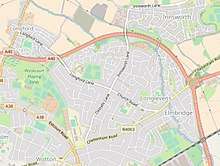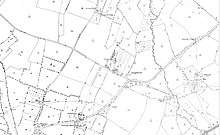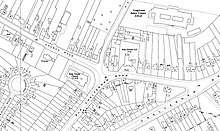Longlevens
Longlevens, originally Longleavens, is a suburb of Gloucester, United Kingdom, developed from a farmstead during the twentieth century. The name may be based on the old Roman name Colonia Glevensis. One of the oldest roads is 'The Avenue', which is shown on old maps as a number of farm cottages. The population of Longlevens was 9,532 at the time of the 2011 Census.[1]



History
Wotton St. Mary (Without), save for a few acres given to Barnwood and Churchdown, was included with parts of Barnwood, Churchdown, and Hucclecote in the new civil parish of Longlevens, north-east of Gloucester. Parts of Longlevens were added to Gloucester in 1951 and in 1967 when the remainder was re-formed as Innsworth civil parish.
Orcharding, which was increased at Innsworth in the mid 19th century, remained an important feature and in 1896 covered at least 172 a. in the parishes of Gloucester, Longford, Tuffley, Twigworth, and Wotton St. Mary (Without). The demands of Gloucester's growing population in the 19th century increased market gardening in the hamlets and by 1843 J. C. Wheeler's nurseries included a large area between Kingsholm and Wotton. In 1851 market gardeners were fairly numerous in Longford and Twigworth, and later there were several market gardens and nurseries at Longlevens (called Springfield) and Innsworth.
Character and facilities
Longlevens is primarily residential, and is home to Sir Thomas Rich's School, Holy Trinity Church,[2][3] Kendal Road Baptist Church,[4] Longlevens Junior School, Longlevens Infants School[5] and various shops and restaurants.
Flooding
Longlevens was severely affected by the July 2007 floods, which caused Horsbere Brook which runs through the village to flood many homes and roads, particularly affecting the Greyhound Gardens area and Cypress Gardens in particular.
Football and greyhound racing
Of clubs playing association football the most important was Gloucester City Association Football Club, originating in 1889 and re-formed in 1925. From 1935 it had its ground at Longlevens and in 1964 it moved to a new stadium in Horton Road, which was later also used for greyhound racing. A more important centre for greyhound racing was the Gloucester & Cheltenham Stadium which opened in 1933 and closed in 1983.
References
- "Gloucester Ward population 2011". Retrieved 27 October 2015.
- Holy Trinity, Longlevens. "Holy Trinity, Longlevens". Holy Trinity, Longlevens. Archived from the original on 11 January 2014. Retrieved 13 February 2014.
- "Gloucester: Modern parish churches", A History of the County of Gloucester: Volume 4: The City of Gloucester (1988), pp. 311-317.
- "Kendal Road Home Page". Krbc.org.uk. 31 January 2010. Retrieved 13 February 2014.
- http://www.longlevensinfantschool.co.uk/blog/
External links
| Wikimedia Commons has media related to Longlevens. |